Simple Musical Instruments DIY
When 8-year-old Mia asked her dad to build a guitar together, they raided their kitchen for supplies. A shoebox, rubber bands, and a wooden spoon became their first homemade creation. Within hours, twangy melodies echoed through their living room—proof that anyone can craft playable sounds with everyday items.
This hands-on approach to music-making isn’t just for kids. Adults across the U.S. are rediscovering the joy of building rhythm shakers from coffee cans or fashioning stringed pieces from reclaimed wood. The process blends creativity with basic physics, revealing how vibrations transform into harmonies.
Modern DIY culture has turned homes into miniature workshops. Online communities share blueprints for everything from bamboo flutes to cardboard drum kits. Projects range from 30-minute activities to multi-week challenges, accommodating all skill levels. You don’t need fancy tools—just curiosity and a willingness to experiment.
What makes these creations special isn’t just their sound. It’s the satisfaction of turning raw materials into something that sings. As you’ll discover, crafting your own pieces deepens your connection to music’s building blocks while sparking endless creative possibilities.
Key Takeaways
- Transform household items into functional noisemakers
- Explore sound science through hands-on projects
- Find communities offering free tutorials and support
- Choose quick builds or complex challenges
- Learn how materials affect tone and resonance
- Develop new skills while creating unique pieces
Introduction: Embrace the DIY Music Adventure
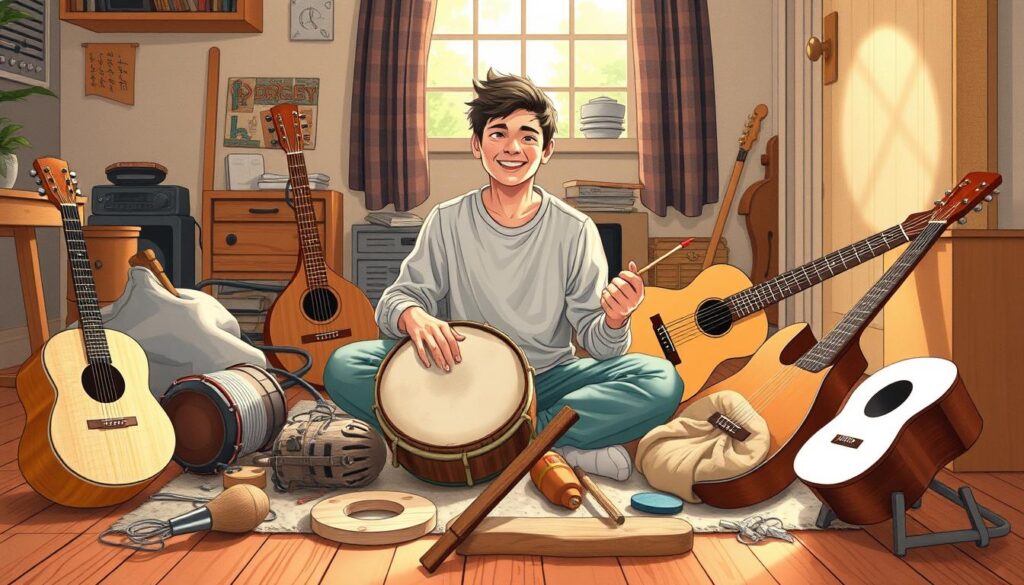
For over a century, museums like The Met have celebrated humanity’s relationship with sound through their collections. Mary Elizabeth Adams Brown’s 3,600-piece assortment shows how every culture shaped melodies using local materials—a tradition anyone can continue today.
Why Build Sound-Making Tools?
Crafting your own noisemakers bridges ancient traditions with modern creativity. You’ll discover how reeds vibrate or how drum skins amplify beats—lessons in physics disguised as play. Families bond over decorating rainsticks made from cardboard tubes, while solo makers refine woodworking skills.
Perks for Crafters and Players
Homemade pieces cost pennies compared to store-bought gear. A tin-can banjo teaches tonal basics as effectively as a $200 model. Plus, understanding construction helps musicians improve their playing technique naturally.
| Aspect | DIY Creations | Store-Bought Gear |
|---|---|---|
| Cost | $5-15 materials | $50-500+ |
| Learning Value | Hands-on physics & design | Prefab components |
| Customization | Endless personalization | Limited options |
| Family Activity | Group project friendly | Solo purchase |
Exploring global designs in your workshop becomes a cultural study. Why do bamboo flutes dominate Asian music? How did African thumb pianos evolve? Each project answers these questions through hands-on discovery.
Exploring Musical Instruments for Your DIY Projects
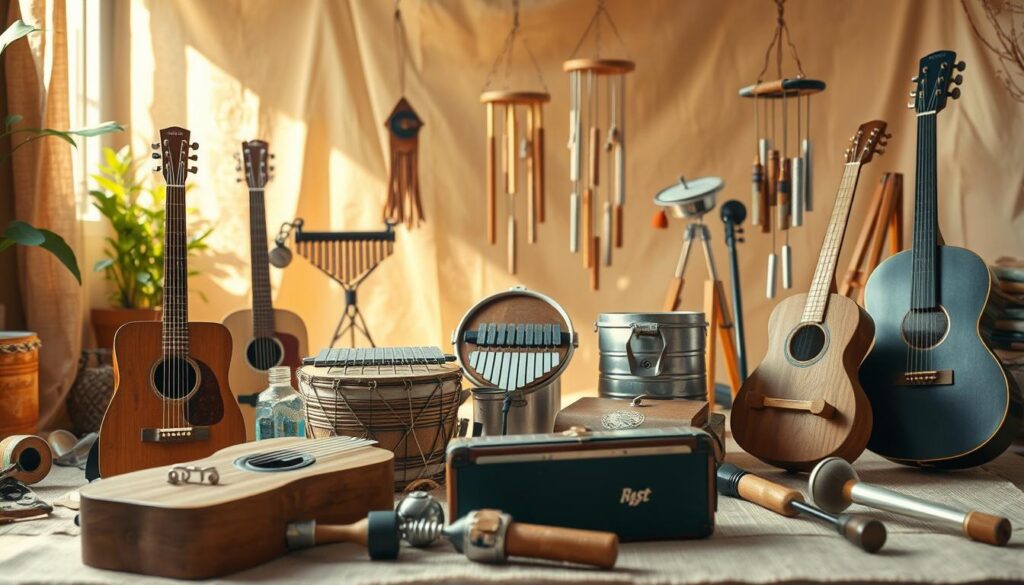
Every culture has shaped sound through creative tool-making, from hollowed gourds to carved wood. Today’s crafters can explore four core categories of noisemakers—each offering distinct lessons in design and acoustics.
An Overview of Instrument Types and Styles
String-based creations teach how tension and length affect pitch. Rubber band guitars or cigar box fiddles reveal why maple produces warmer tones than pine. These projects often become gateway builds for understanding musical physics.
Percussion pieces win for accessibility. Coffee can drums or bottle cap tambourines need only basic tools. They’re perfect first projects for testing how materials influence resonance.
Inspiration from Traditional and Modern Sources
Global designs spark fresh ideas. Bamboo flutes from Asia demonstrate precise hole spacing, while Andean pan pipes showcase layered tuning. Modern makers blend these concepts with 3D-printed parts or waterproof coatings.
Brass and wind pieces challenge advanced builders. A homemade trumpet requires careful bending of copper tubing, but rewards with proper buzzing tones. These builds connect crafters to centuries of acoustic innovation.
Whether reviving ancient techniques or experimenting with new materials, DIY instrument-making turns everyday objects into personalized sound machines. The key lies in choosing projects that match your skills while expanding your understanding of sonic principles.
DIY Percussion Instruments: From Drums to Tambourines
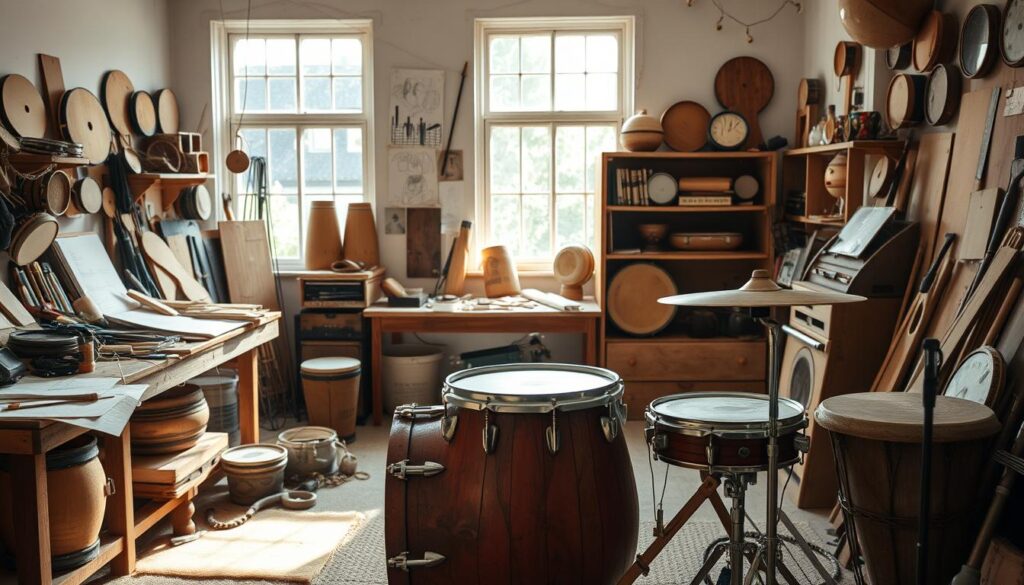
Rhythm lives in every heartbeat and thunderclap. Building your own beat-makers lets you harness this primal energy using items from your garage or craft drawer. These projects reveal how vibration turns ordinary materials into powerful sound sources.
Simple Drum and Frame Drum Projects
Start with a coffee can or flower pot. Stretch balloon rubber or vinyl across the opening, securing it with duct tape. Pro tip: Use different-sized containers to create distinct pitches. Larger vessels produce deeper tones, while smaller ones deliver sharp snaps.
Frame drums offer ancient design simplicity. Cut a circular plywood base (12-18″ diameter) and drill holes around the edge. Lace synthetic leather across the frame with paracord, adjusting tension until you get clear resonance. This method echoes techniques used in Middle Eastern daf drums for centuries.
| Feature | DIY Version | Pro Gear |
|---|---|---|
| Cost | $0-10 | $80-300 |
| Tuning | Rope adjustments | Mechanical lugs |
| Materials | Upcycled items | Specialty woods |
| Project Time | 1-3 hours | Factory-made |
Tambourines combine shaking and striking elements. Attach bottle caps to a wooden hoop using upholstery nails. For brighter jingles, try repurposing old keys—their metallic clang adds unique texture. Experiment with placement patterns to control the sound intensity.
Remember: Your materials shape your music. Cardboard boxes create muffled beats, while metal cans deliver crisp attacks. Test different combinations to find your signature rhythm voice.
DIY String and Wind Instruments: Easy Projects for Beginners
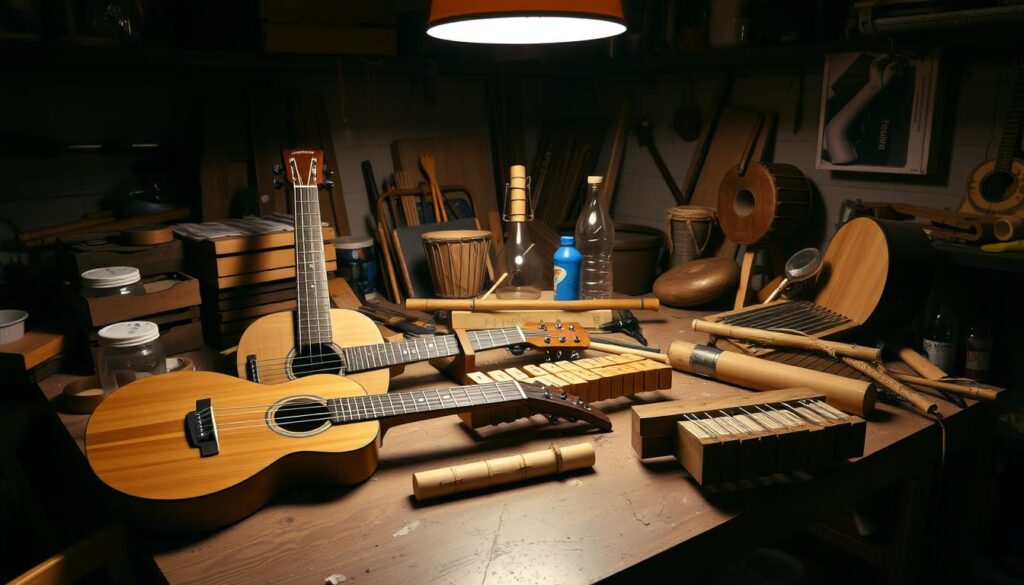
Unlock the secrets of melody-making by crafting your own noisemakers. Building string and wind pieces teaches core acoustic principles while sparking creativity. Let’s explore how everyday materials transform into expressive tools.
Building Guitars, Violins, and Flutes at Home
Cigar box guitars make perfect starter projects. Attach three strings to a wooden board, using matchboxes as bridges. This simple build reveals how string length affects pitch—shorter lengths create higher notes. Decorate your creation with paint or carvings for personal flair.
Violin construction demands precision but offers rich rewards. Shape a spruce top with careful carving to create the iconic f-holes. “The soundboard’s curvature determines resonance quality,” notes luthier Emma Reyes. While challenging, these builds help musicians understand tone production at its source.
For wind enthusiasts, PVC pipe flutes deliver instant gratification. Drill six finger holes using this formula:
- First hole: 3/8″ diameter, 5″ from mouthpiece
- Subsequent holes: 1/2″ apart
- Final hole: 9″ from pipe end
Test different materials—bamboo produces warmer tones than metal. Advanced builders can experiment with slide mechanisms for chromatic scales. Each project deepens your grasp of acoustic physics while creating playable art.
Tools, Materials, and Creative Techniques
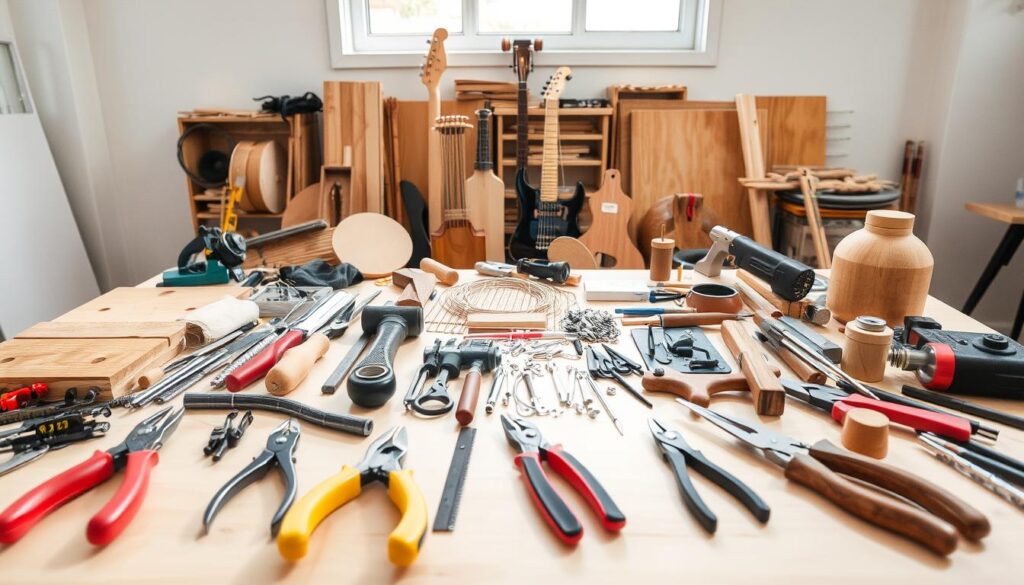
Crafting instruments at home transforms ordinary materials into extraordinary sound-makers. The right supplies and methods turn kitchen tables into workshops where rubber bands become strings and scrap wood sings. Let’s explore what you need to start shaping sound with your hands.
Essential Materials for DIY Instrument Crafting
Quality wood forms the backbone of great builds. Spruce and cedar create bright soundboards, while maple adds durability to necks. For keys and fingerboards, dense woods like ebony deliver crisp articulation. Basic tools—saws, clamps, and sandpaper—lay the foundation, while precision drill bits ensure accurate hole placement.
Organized workspaces boost efficiency. Good lighting reveals wood grain patterns, while ventilation protects against dust. Store tools within arm’s reach but keep flammables separate. Pro tip: Use pegboards for hanging chisels and measuring tapes—saves space and prevents clutter.
Step-by-Step Creative Techniques
Planning prevents frustration. Sketch designs first, noting measurements for bridges and soundholes. For keyboard projects, mark key spacing with painter’s tape before drilling. Modern wood glues create stronger bonds than traditional hide glues, cutting assembly time in half.
Steam bending opens new design possibilities. Soak thin wood strips before shaping them around molds for curved bodies. This technique works wonders for squeezebox-style accordions and arched piano lids. Though time-intensive, these methods yield professional-grade results.
| Material | Best Use | Drying Time |
|---|---|---|
| Spruce | Soundboards | 2-4 weeks |
| Maple | Neck construction | 1-2 weeks |
| Rosewood | Fingerboards | 3-5 days |
Complex builds like pianos demand patience but offer huge rewards. “Proper key leveling makes or breaks playability,” says Boston piano maker Luis Chen. Start with small percussion pieces before tackling 88-key projects. Remember—every masterpiece begins with simple first steps.
The History and Cultural Impact of DIY Musical Creations
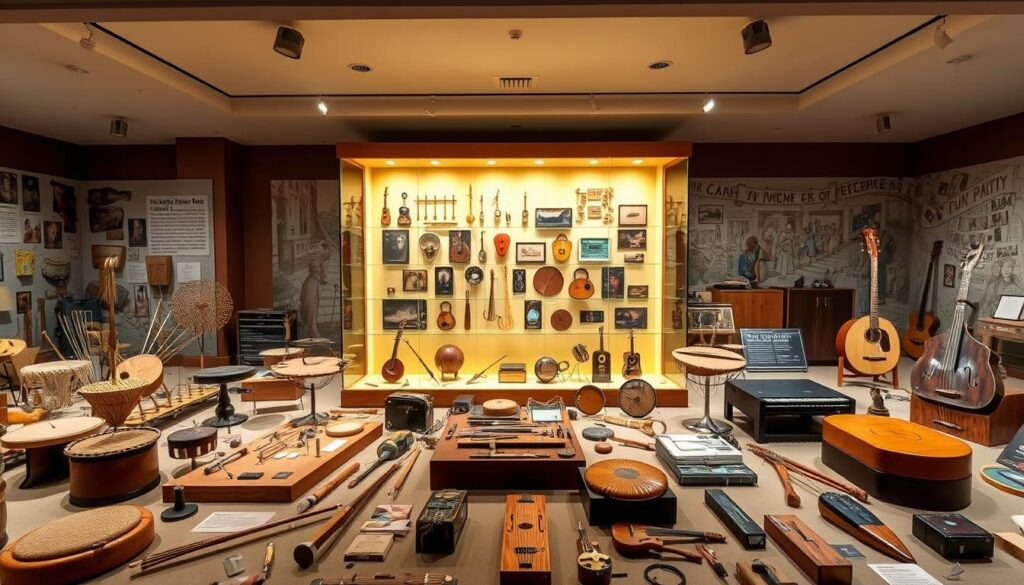
Museum vaults hold secrets that fuel modern creativity. The Metropolitan Museum’s collection of 5,000 sound-making tools—some dating to 300 BCE—shows how every culture engineered melodies from local materials. From African thumb pianos to Andean panpipes, these artifacts prove homemade noisemakers shaped human expression long before music stores existed.
Insights from Museum Collections and Exhibitions
Mary Elizabeth Adams Brown’s legendary 3,600-piece collection reveals a truth: Great makers balance function and beauty. Her 1720 Cristofori piano and Stradivari violins weren’t just tools—they were cultural statements. “Every scratch tells a story of innovation,” says Met curator Bradley Strauchen-Scherer.
Modern crafters draw inspiration from these masterpieces. The cello‘s evolution from 16th-century bass violins demonstrates how player feedback drives design changes. Historical exhibits prove that famous musicians often tweaked their gear, much like today’s DIY enthusiasts modify guitar pickups.
Evolution of Instrument Making Through the Years
Early makers used whatever materials their world provided:
- Desert cultures crafted drums from dried gourds
- Arctic communities made whistles from seal bones
- Rainforest builders used termite-hollowed bamboo
This resourcefulness continues today. While 18th-century luthiers aged wood for a year before carving, modern makers experiment with 3D-printed resins. The table below shows how techniques evolved:
| Era | Materials | Innovation |
|---|---|---|
| Pre-1600s | Animal hides, clay | Hand-carved wind pieces |
| 1700s | Aged hardwoods | Precision string spacing |
| Modern | Recycled plastics, LEDs | Electronic hybrid designs |
From village ensemble instruments to concert hall masterpieces, the drive to create persists. As you build your next project, remember—you’re adding to a tradition that’s shaped human connection for millennia.
Conclusion
Transforming everyday items into music-makers isn’t just a hobby—it’s a journey into acoustic discovery. This article has shown how simple materials become tools for artistic expression, from rubber-band guitars to hand-carved cello bodies. Each project blends science with creativity, teaching physics through hands-on play.
Whether building a family ensemble or refining solo skills, DIY creations offer unique rewards. You’ve learned how different materials shape sound, why instrument designs vary across cultures, and where to find supportive communities. These skills turn coffee cans into drums and wooden boards into stringed masterpieces.
Now’s the time to start your own sound experiment. Share photos of your first cigar-box guitar or upcycled wind piece. Compare notes with other makers in online groups. Every creation adds to humanity’s rich tapestry of music innovation—one hammered nail and tuned string at a time.
Keep this guide handy as you explore new projects. Bookmark the page or create an account to save favorite tutorials. Who knows? Your next build might spark a lifelong passion—or inspire someone else’s kitchen-table symphony.
FAQ
What’s the easiest percussion instrument to make at home?
Can I build a functional string instrument without professional tools?
How do wind instruments like flutes work in DIY projects?
What materials are essential for crafting DIY instruments?
Are DIY instruments culturally significant?
Where can I find inspiration for unique designs?
How long does it take to complete a beginner-friendly project?

Sharon Molly is a content creator in lifestyle, fashion, and travel, delivering style-savvy advice and destination insights to inspire confident living. With a background in digital media, she combines aesthetics with practical guidance for modern women on the go.




